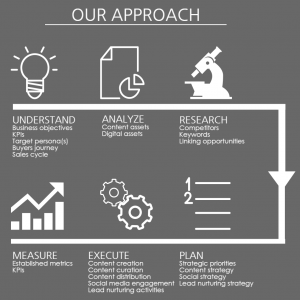
by Fronetics | Jul 27, 2016 | Blog, Content Marketing, Marketing

Effective content marketers have these four things in common.
Think your content marketing could be better? You are not alone. Only 30% of content marketers feel they are effective, and, according to a recent survey, 55% of B2B marketers say they do not actually know what an effective or successful content marketing program looks like.
In fact, some of the key findings from the report, B2B Content Marketing 2016: Benchmarks, Budgets, and Trends – North America, may surprise you.
Recognizing success
First, the team must understand what they are striving for:
- Only 44% of B2B marketers say their organization is clear on what content marketing success or effectiveness looks like; 55% are uncertain. For success, everyone must understand what to look for.
- Only 32% of B2B marketers consider themselves sophisticated or mature in their skill-level. Sixty-four percent of those in the sophisticated/mature phase say they are effective at content marketing, while only 23% in the less-experienced adolescent phase express confidence. But, when strategies are documented, it appears to increase the confidence and success at every skill level.
What makes a team more effective at content marketing?
One key theme that emerged from the survey is that effective content marketers do these four things.
1) They know what effective content marketing looks like.
Effectiveness can be defined as meeting your overall goals and objectives — but in order to do so, those goals must be clear. B2B organizations that have a clear vision of content marketing success are more effective than those that do not. In fact, 79% of the most effective marketers report having that clarity, while 77% of the least effective say they lack it.
2) They have continuous communication.
The most effective B2B marketers (61%) meet daily or weekly with their content marketing team — either virtually or in person. Fifty-four percent say team meetings are valuable.
3) They document their content marketing strategy.
Documenting your content strategies can directly improve a marketer’s overall effectiveness. Fewer B2B marketers are doing this (32% in 2016 vs. 35% last year), even though research supports that a documented strategy can significantly improve results.
4) They document their editorial mission/long-term goals.
Research found that 48% of the most effective content marketers also have a documented editorial mission statement. This statement clearly defines who your audience is and why your content will be effective — it defines your brand. You should also document any long-term goals, like lead generation and sales, for example, will be the most important for most B2B content marketers over the next 12 months.
Having clear communication, documented goals, and defined strategies will provide direction, which can be the guiding light to effective content marketing. Implement these proven steps to better focus your team and to make effective content marketing clear and recognizable.
Related posts:

by Fronetics | Jul 26, 2016 | Blog, Content Marketing, Marketing, Social Media, Strategy

Your business should be on social media showing buyers that you know what they want and that your business can provide it.
Once again B2B buyers reported that their purchase cycle has increased since last year. That’s in part because they are scrutinizing potential vendors more closely than ever before. Buyers overwhelmingly reported spending more time conducting research (80%) and using more sources to investigate purchases (73%).
You may be surprised to learn that one of those sources is social media, more often than not. More than half (53%) of B2B buyers report turning to social media to make buying decisions. What’s more, more than a third (34%) say they are spending more time this year than last using social media to research vendors and solutions.
Social media should be a critical component of your lead generation and nurturing strategy. Your business should use these platforms to prove that you understand what buyers are expecting from your brand. The 2016 B2B Buyer’s Survey Report found that today’s B2B buyers expect:
- Timely responses to messaging: Demonstrating a timely response to questions helped make the sale 98% of the time.
- Strong knowledge of the company and its needs: Personalization ranked as the second most influential reason a buyer chooses a specific vendor. When researching potential products, 64% gravitated toward companies that demonstrated “a stronger knowledge of our company and its needs.” A whopping 84% chose a vendor that could solve one of their pain points.
- Clear demonstration of ROI: Buyers reported conducting a more detailed ROI analysis before making a purchase. Vendors who can demonstrate how customers will receive their return on investment have a clear advantage. In fact, 90% of businesses that do this make the sale, according to the study.
- Speedy and easy delivery: “Deployment time/ease of use” skyrocketed from 49% in 2015 to 83% this year, leading the ranks as one of the most important variables that can set you apart from your competition. Buyers not only want it quickly, but they want a simple and easy buying process.
Which social media platforms do B2B buyers use most in their research?
The B2B Buyer’s Survey found that buyers primarily are using three social tools to conduct their research.
- LinkedIn is reportedly the most impactful to the research process. (81% said it was very important or somewhat important.)
- Blogs came in second, with more than a third of buyers (37%) ranking it very important.
- Video sites like YouTube and Vimeo are third, with 60% of respondents ranking them very important or somewhat important.
Want your business to connect with the 2.3 billion worldwide social media users? Get Fronetics’ free social prospecting workbook to learn how to use these platforms to generate new leads and sales for your business.
Related posts:

by Fronetics | Jul 12, 2016 | Blog, Marketing, Strategy

Editor’s note: Sarah Collins is a summer intern at Fronetics Strategic Advisors. She is a rising sophomore at James Madison University, College of Business studying Marketing. You can find her on LinkedIn.
Aligning Sales and Marketing helps companies achieve 20% higher annual growth rates and improves deal closings by 67%.
“What do you think you’ll do with that?” is the question that, more often than not, succeeds me stating that I’m a marketing major. Uh, market? I guess? I’m the kind of student that usually has it all figured out. There’s always a game plan, so to speak, but this time around I had some figuring out to do.
That’s where Fronetics came into play for me. I went into my first intern experience looking at it as a giant learning opportunity. As I began, one of the first things that surprised me was that there were sales people in a marketing office. Little did I know, this is the ideal situation in the industry. Finally, the advice that a mentor gave me — “Take sales classes. You’ll thank me later.” — made sense. Marketing and Sales are like the Batman and Robin of the business world: Results are best when they’re working together.
What’s the reasoning behind aligning Sales and Marketing?
Through my research, I’ve learned that aligning Sales and Marketing goes back to a basic business concept, the buyer process: awareness, consideration, decision. The ultimate goal in business is essentially the same across the board. Sell and provide your product or service to your target audience. In order to achieve this, it’s best to focus on what the buyers’ immediate needs are at each individual stage of the buying process, and Marketing and Sales excel at different stages of this process.
It relates back to my economics class. Countries will always specialize in what they have the comparative advantage in because, when those two countries trade, they both end up with more than what they would have produced on their own. So Marketing and Sales specialize in their own stages of the buying process, and, in the end, they’re both better off.
HubSpot gives a great example. It wouldn’t make any sense for Sales to try to sell the product to a lead that has entered the awareness stage. At that point, the lead is only looking for specific information. It’s a strength to know where the customer is at and who is best fit to assist.
Why should you believe me?
According to ZoomInfo, only 8% of companies have strong alignment between their sales and marketing departments. Those that are aligned correctly statistically achieve a 20% higher annual growth rate and are 67% better at closing deals. As Articulate Marketing puts it, people are too informed in this day and age to tolerate even the slightest gap in what different departments tell them. The sales process has changed because the internet has given people access to so much information, and companies need to adapt accordingly.
Marketing and Sales are still two different entities.
While the two departments desperately need to be aligned well, there is no denying that they are, in fact, different. Sales generally has short term, tangible goals — such as new-client generation — while marketers are looking farther ahead at goals that aren’t quite as easy to measure.
The movie The Wolf of Wall Street offers a fantastic demonstration of how Sales works. Jordan Belfort (Leonardo Dicaprio) asks his friend Brad to sell him a pen. Brad simply says, “Write this down.” Mr. Belfort now has an immediate need for the pen. Salespeople have the ability to create this need for the buyer.
In an article by the Tronvig Group titled The Difference Between Sales and Marketing, James Heaton states that, in contrast to Sales, “Marketing should put forth an offer that meets the buyer’s needs right at the place and time of the sales opportunity. The most effective marketing is therefore about communication, not manipulation.” It’s when these differences between Sales and Marketing finally begin to work together that all the bases are covered, and the magic begins to happen.
How should companies align Sales and Marketing?
There are two main ways: strategically and physically.
Strategic Alignment
You can ask Sales and Marketing to collaborate in defining a lead generation strategy. This way the two departments aren’t getting frustrated with each other. Marketo highlighted three ways to do so.
- Lead Scoring can be incredibly helpful in understanding which leads are most interested and how good of a fit their company is for your business. These scores are only helpful if Sales and Marketing have worked together to create mutual understanding of the system.
- Lead Generation Metrics need to be understood by both. It won’t work if marketing doesn’t understand what is qualified as a SAL (Sales Accepted Lead) and SQL (Sales Qualified Lead), or if Sales doesn’t understand what makes up an MQL (Marketing Qualified Lead). A mutual understanding will increase efficiency because each department knows exactly what the other is looking for.
- Service Level Agreements can ease the process by outlining each phase of the cycle. For example, when an MQL is handed off to the Sales team, how long does the Sales team have to get in contact? What if they don’t at all? If the system becomes automated enough, you can expect a higher level of performance because the system will provide documentation on how someone became an MQL, and sales will have a record off their contact.
Physical Alignment, aka the Office
The physical layout of the office is also crucial. A study done in 2015 by CEB found that when employees are satisfied with their physical work space, they are 16% more productive and 18% more likely not to quit. Harvard Business Review found the open-concept office, having Sales and Marketing in the same space, resulted in more successful communications. One pharmaceutical company even found that the sales jump was more than 20%, $200 million in revenue.
The statistics are all there showing how detrimental or incredibly helpful aligning Sales and Marketing teams can be.
So have I exactly figured out the answer to my question? Not completely, but there’s still time. What I have learned is that the only choice to make regarding Marketing and Sales is that there is no room for competition between them, and I should definitely be mixing a sales class into a semester or two. Learning early that Sales and Marketing are both essential to each other and gaining experience in both skillsets could be just the competitive edge I need for my future. Lucky for me, there’s three more years of learning to be had.
Related posts:

by Fronetics | May 24, 2016 | Blog, Content Marketing, Marketing, Strategy

Outsourcing content marketing can cost a fraction of what dedicating in-house resources would — and you’ll get better results.
Nobody can do it all, despite what the latest motivational meme tells you. When running your business, it is vital that you focus on where you excel; sticking with your core competency is critical. Essentially, the more hats you wear in your company, the more watered down your efforts become.
Content marketing can be highly effective in generating leads and driving sales, but doing it right requires significant time and effort. If you are trying to manage content on top of overseeing key aspects of your business’ day-to-day operations, you are stretching yourself thin. What’s more, it’s negatively impacting your bottom line.
Why DIY content marketing can be costly
Many companies mistakenly think that managing their content marketing in house is simple, cost effective, and not time consuming. Actually, nothing could be further from the truth. Here is why:
Lost hours on your job
Taking time away from your primary focus prevents you from doing your job. If what you do best is new product development, for example, then dedicating hours each week to writing blog posts means that much less time for market research, design, and implementation. Those few hours away each week add up over time, and the cost to your company is significant.
Lost leads and sales opportunities
You may be a good writer and have personal social media accounts, but do you understand the ins and outs of creating and distributing content in a business setting? Professional content writers have expertise in search engine optimization (SEO), branding, user experience, and storytelling — all of which drive traffic and generate leads. Social media strategists similarly have expert knowledge of networking sites and how to best reach a target audience. If you don’t have that expertise, you are costing your company those opportunities — or, again, taking time away from your primary function trying to learn.
Lost readership and audience retention
If your content does not engage your audience, you shouldn’t have bothered in the first place. And engaging content doesn’t occur by happenstance. Research shows a strong correlation between content marketing success and strategy, documentation, and frequent check-ins. You need to know exactly who your audience is and what they want to read, and then you need a long-term plan for continually reaching them in new and interesting ways. Then you need to regularly assess your strategy and adjust as needed. As you can imagine, that all takes time and focus.
According to Forbes, outsourcing your content marketing is a cost-effective way to increase the success of your program. Essentially, you get expertise and experience — at a fraction of the cost of dedicating in-house resources — with no long-term commitment. By allowing experts to create strategies and leverage well-crafted, engaging content across multiple channels, you can improve lead generation and exponentially increase sales.
The Takeaway
By outsourcing your content marketing to the right firm, you can:
- Get professionally written, optimized content that engages your target customer and builds relationships.
- Benefit from the firm’s experience with content marketing for your industry and beyond.
- See results and ROI. The firm should put metrics on all of your marketing activities and deliver a regular report to you so you can monitor progress.
- Save time and money: You can focus on the core aspects of growing your business, while outsourcing your content marketing costs a fraction of dedicating in-house resources.
Simply put, it ultimately costs less to let experts create and execute your content. Given the reins, they can leverage their experience to produce greater results, capture more leads, analyze results, revise strategies, and, most importantly, free up your schedule to focus on your key responsibilities.
Related posts:

by Fronetics | May 18, 2016 | Blog, Content Marketing, Marketing, Strategy, Supply Chain
Fronetics’ six-step approach to content delivery helps elevate our clients’ brand position within the industry and drives growth.
The B2B buying process has evolved, and content is now an essential tool for generating and nurturing leads. Many businesses understand this: Reportedly, 88% of B2B marketers use content marketing as part of their programs, with lead generation (85%) and sales (84%) being the most important goals.
Many companies, however, find producing consistent, quality content — essential to a successful content marketing program — very challenging. Most don’t have the resources to make content a first priority, and many are unclear on what kinds of content will work for their business.
Fronetics Strategic Advisors partners with clients to create a content marketing program that drives growth. Handling all aspects from strategy to execution, our team leverages our vast and varied experience to deliver content that will elevate our clients’ brand position within their industry.
Our six-step approach to deliver content for our clients in the supply chain and logistics industries:
 Understand
Understand
Our first priority is to work with you to create the most effective content marketing strategy for your company. That means fully understanding the specifics of your business — your target customers, your sales cycle, your KPIs, and your competition — in order to create a content strategy individualized for your specific situation and needs.
Analyze
Next, we audit your digital assets: what is in place and how well it is working to produce your desired results. What kinds of content are you producing, how often are you producing it, and what is resonating with your target audience?
Research
We examine who your competitors are and what they are doing well (and not so well), identifying any gaps in the marketplace. We also research keywords that will resonate with your target audience and identify linking opportunities that will direct potential customers to your website.
Plan
We work closely with you to establish strategic priorities. We develop content, social media, and lead-nurturing strategies built on our careful research, understanding of your business goals, and analysis of the marketplace.
Execute
We begin creating, curating, and distributing content for your business. Unlike other firms, we don’t outsource content creation. By keeping it all in-house, we are able to ensure a quality product. Our team can create:
- Blog posts
- Articles
- eBooks
- Case studies
- White papers
- Newsletters
- Press releases
- Infographics
- Social media
- Custom content
Measure
Finally, we put metrics on all of these activities, monitor them regularly, and provide you with a monthly marketing report. We identify challenges, trends, and opportunities and take action so that your content marketing program constantly evolves and delivers results.
If you are looking to improve your content marketing to drive meaningful engagement with prospects and customers, speak with us today.
Related posts:







 Understand
Understand